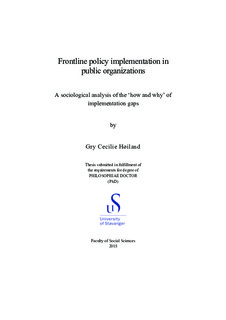| dc.contributor.author | Høiland, Gry Cecilie | |
| dc.date.accessioned | 2018-10-30T11:46:25Z | |
| dc.date.available | 2018-10-30T11:46:25Z | |
| dc.date.issued | 2018-10 | |
| dc.identifier.citation | Frontline policy implementation in public organizations : A sociological analysis of the ‘how and why’ of implementation gaps by Gry Cecilie Høiland. Stavanger : University of Stavanger, 2018 (PhD thesis UiS, no. 416) | nb_NO |
| dc.identifier.isbn | 978-82-7644-796-5 | |
| dc.identifier.issn | 1890-1387 | |
| dc.identifier.uri | http://hdl.handle.net/11250/2570121 | |
| dc.description.abstract | Background and aims Innovation is promoted in politics and public service organizations as an essential factor for meeting the demands of society. How new policies or strategies can be implemented as intended in complex multi-level public organizations is a major practical and academic puzzle. We know from extensive research that there is often a gap between central policy formulations and their implementation in practice (Hill & Hupe, 2003; Hupe, 2014) created by frontline workers exercise of discretion and their outcomes (Lipsky, 1980, 2010). However, there is a need for empirical
research on the ‘how and why’ of street-level implementation (Hupe, 2014) such as ‘how the workers actually arrive at their decisions’ (Goldman & Foldy, 2015 p.169), as well as the use of multi-leveled perspectives to investigate the problem of implementation gaps (Hupe, 2014). The thesis aims to investigate mismatches between centrally directed policy measures and their implementation on the operational level. Introducing the concept of ‘resistance-driven innovation’, the thesis challenges the normative tendency of viewing implementation gaps as implementation failures (Hupe & Hill,
2016). In order to realize the thesis’ aim, a critical realist informed case study was used to explore the top-down implementation process of a specific work inclusion policy measure within the Norwegian Employment and Welfare Services (NAV). The thesis aim is operationalized into research questions and dealt with in three separate articles as well as summarized and elaborated on in chapters 5, 6 and 7 as follows:
a. What do the multi-level implementation context and process of the specific policy measure in NAV look like?
b. How did frontline staff at the case office of NAV perceive and respond to the implementation efforts of the policy measure in focus?
c. Why was the Facilitation Guarantee not implemented as intended at the case office?
d. What are the theoretical implications, mainly for the street-level policy implementation research field, but also for the fields of institutional logics and employee-based innovation?
e. What are the implications for the planning and management of implementation processes?
Research design. The critical realist informed case study explores the topdown implementation process of the work inclusion policy measure called the Facilitation Guarantee within NAV, tracing it through all levels of NAV to a specific frontline case office. The case study included two successive and interacting main phases: first, the exploration of the implementation context, process and strategies of the policy measure at the various hierarchical levels of NAV, and then exploration and explanation of reactions to its implementation instructions among the frontline employees at the selected case office. The case study included in-depth semi-structured interviews, document studies and meeting observations. The case study included methods of in-depth semi-structured interviews, document studies and meeting observations. For the first phase, data material was collected during a 14 month period, December 2014 – January 2016 consisting of an exploratory document study of internal reports, guidelines, instructions etc. as well as 21 semi-structured interviews of 16 informants distributed at various levels of the organization, including managers and implementation coordinators. The second phase of the study, focusing on the selected frontline case office during the 4 last months of 2015, included 11 one-to-two hour-long interviews with frontline employees, as well as interviews from three of the informants from the first phase. The interviews were supplemented with observations from 24 case and department meetings. Together, the two phases consisted of a total of 32 interviews with 27 informants. Drawing on a CR informed methodology (e.g. Edwards, O'Mahoney, & Vincent, 2014) the empirical findings from the interviews and observations were analyzed in the light of the wider contextual understanding that the full case study provided. The subsequent findings were continuously analyzed to explore mechanisms that could best contribute to an explanation of the way that the implementation instructions were met by the frontline employees (Belfrage & Hauf, 2017). | nb_NO |
| dc.language.iso | eng | nb_NO |
| dc.publisher | Stavanger: University of Stavanger | nb_NO |
| dc.relation.ispartofseries | PhD thesis UiS;416 | |
| dc.relation.haspart | Høiland, Gry Cecilie, & Willumsen, Elisabeth (2016). Understanding implementation in complex public organizations – implication for practice. Journal of Comparative Social Work, 2016(2), 1–29. | nb_NO |
| dc.relation.haspart | Høiland, Gry Cecilie & Klemsdal, Lars. Institutional logics as tools for maneuvering top-down implementation instructions. (Submitted 2018) | nb_NO |
| dc.relation.haspart | Høiland, Gry Cecilie, & Willumsen, Elisabeth. Resistance-driven innovation? Frontline public welfare workers’ coping with top-down implementation. Nordic Journal of Work Life Studies, 8 (2). | nb_NO |
| dc.rights | Navngivelse 4.0 Internasjonal | * |
| dc.rights.uri | http://creativecommons.org/licenses/by/4.0/deed.no | * |
| dc.subject | innovasjon | nb_NO |
| dc.subject | NAV | nb_NO |
| dc.subject | organisasjonspsykologi | nb_NO |
| dc.subject | implementering | nb_NO |
| dc.subject | tilretteleggingsgaranti | nb_NO |
| dc.subject | sosiologisk analyse | nb_NO |
| dc.title | Frontline policy implementation in public organizations : A sociological analysis of the ‘how and why’ of implementation gaps | nb_NO |
| dc.type | Doctoral thesis | nb_NO |
| dc.rights.holder | ©2018 Gry Cecilie Høiland | nb_NO |
| dc.subject.nsi | VDP::Samfunnsvitenskap: 200::Sosiologi: 220 | nb_NO |

